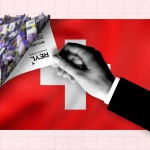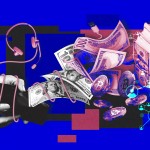What is a Laundromat?
A Laundromat is an all-purpose financial vehicle, typically set up by a bank or other financial services company, that is intended to help clients launder the proceeds of crime, hide ownership of assets, embezzle funds from companies, evade taxes or currency restrictions, and move money offshore. OCCRP coined the term with its 2014 investigation into the “Russian Laundromat.”
A Laundromat is the financial-world equivalent of TOR - software that allows complete anonymity when browsing the internet. Just like TOR, Laundromats allow people to split money laundering between many banks so that no bank has a complete overview of what is going on, or of the entire amount being laundered.
Laundromats are made up of companies in jurisdictions across the world that are seemingly independent but controlled by a single party — usually the bank. A client wires money to a node in the network, often using fake paperwork showing a good or service is being bought or sold. From there, it’s parceled out to the other nodes, accompanied by more bogus paperwork. Eventually, the money is sent to an offshore company or other destination chosen by the client (minus a commission for the Laundromat’s operators). The ownership and origin of the money is lost in the dizzying myriad transactions, rendering it nearly untraceable even by law enforcement.
How many Laundromats are there?
As of 2020, OCCRP has uncovered four major Laundromats: The Proxy Platform, the Russian Laundromat, the Azerbaijani Laundromat, and the Troika Laundromat. These systems were set up by Latvian, Lithuanian, Moldovan, and Russian banks. Some are interconnected. None of them have been entirely explored. We’ve since uncovered a few more but haven’t finished analyzing them. It’s a sure bet that more and larger Laundromats are out there waiting to be discovered.
How are Laundromats found?
The Laundromats revealed by OCCRP operated for years before being discovered by reporters. Though their existence was suspected by financial crime specialists, law enforcement bodies never seemed to grasp their entirety. One reason is their complexity and cross-border methods of operation. Laundromats are made up of dozens or hundreds of companies that have bank accounts in different countries and are registered in secretive offshore jurisdictions where records are not transparent.
OCCRP has pieced together the operation of these Laundromats through bank records and other documents received from confidential sources, law enforcement, and court cases. By carefully analyzing these records, we identify some companies acting as nodes, trace the movement of money, and gradually determine the outlines of a coherent Laundromat.
Are Laundromats illegal?
This is a very complex question, and in each case it’s up to prosecutors to determine whether any laws were broken. But which prosecutors, and which laws? A Laundromat involves people in many countries wiring money to bank accounts in many others, often through companies in yet another place. And that’s a simple case. In determining whether a crime has occured, each jurisdiction uses its own definition of money laundering and tax evasion.
Moreover, though laws are national, many of these transactions are international.
The bank accounts used in Laundromats can be denominated in any of a number of currencies, making them subject to yet another set of jurisdictions. For example, a dollar transaction in a Russian bank may come under U.S. jurisdiction.
Most laundromats rely on forged paperwork that hide the laundering under what appears to be a real transaction — selling steel or buying vegetables. In fact, no real trade takes place. Known as trade-based money laundering, this is almost always illegal.
To complicate the picture still further, some Laundromat users may be engaged in legitimate business, simply finding that using such a system is easier than more regular or official channels.
On the other hand, OCCRP has found Laundromat transactions involved in dozens of frauds, including the theft exposed by the late Russian lawyer Sergei Magnitsky and transactions by the Mexican Sinaloa drug cartel.
Even Laundromat transactions that don’t rise to the level of known criminality involve questionable practices, sometimes involving major world figures. Both the Russian and Troika Laundromats showed major Russian businesses giving millions of dollars to a cellist who is an old friend of President Vladimir Putin, for example.
What do we know about where the money went?
Having used a Laundromat to obliterate any trace of their money’s origin, clients can direct it to wherever they want. In most cases, the ultimate destination cannot be determined, hidden behind endless layers of offshore companies in secretive jurisdictions. In some cases, it ends up directly with vendors of yachts, expensive cars, and luxury properties, or in the pockets of politicians.
What type of checks should the banks have done?
Many bank accounts used in Laundromats uncovered by OCCRP were at banks that had been shut down for bad behavior, with the most notorious being Ukio Bankas in Lithuania, Danske Bank’s Estonian branch, ABLV, Trasta Komercbanka in Latvia, and many others in the Republic of Moldova and Russia.
Bank compliance officers are supposed to look out for suspicious transactions. But many of these banks had dismal compliance records. Laundromat transactions that were obviously suspicious, and should have been flagged, often were not. For example, a company might claim to be trading computers one moment and food the next. There was almost no evidence that these companies ever did any real business. There’s no evidence that bank compliance officers ever asked for documentation such as a utility bill, a rental contract or other proof they were more than shell companies. Other suspicious signs included multiple round-number transactions and bank accounts filled and emptied on the same day.
In fact some of the banks directly involved in the Laundromats were partially owned by the criminals themselves.
The transactions often went through correspondent banks in the U.S. and Europe — including Deutsche Bank, Raiffeisen Bank, Citibank, and HSBC — without being stopped.
What’s wrong with rich people moving money around this way? What’s the harm?
When Laundromat users — who are often quite wealthy — evade taxes or customs fees, the state is deprived of badly needed money.
The situation creates an unfair playing field, making the goods and services of corrupt operators cheaper than those of responsible business operators who pay their taxes and customs fees. Why should rich and well-connected people benefit from such schemes when an average businessman cannot?
There are some valid reasons to hide assets. In countries like Russia, openly owning legitimate wealth can get you in trouble with greedy people in positions of power. Corporate raids are a regular occurrence. Your family could be kidnapped. So it makes sense to hide what you own.
But some people try to hide assets bought with stolen funds. One way to catch corrupt officials is by looking at what they own and comparing it to their legal income. If the assets are hidden, the public may never know there’s a problem.
In the most blatant cases, Laundromats help launder ill-gotten money — literally making crime pay. These funds can disappear into offshore accounts and never be found. Almost every developing country struggles to trace and recover stolen assets.
Opaque money is also opaque power. Money that has passed through a Laundromat may show up in other countries to bribe local officials, buy positive news coverage, or empower extremist groups. It’s best to know whose money is whose.
How are the Laundromats connected to the Panama Papers?
The Panama Papers were documents from the Panamanian law firm Mossack Fonseca that were leaked to the German newspaper Süddeutsche Zeitung. The International Consortium of Investigative Journalists and the German paper shared the documents with OCCRP and dozens of other media organizations that came together to report on them.
Many companies that appeared in the Panama Papers are offshores set up to hide business transactions. Some of them may have been part of Laundromat-like structures. Others were set up to connect with Laundromats, including those uncovered by OCCRP.




